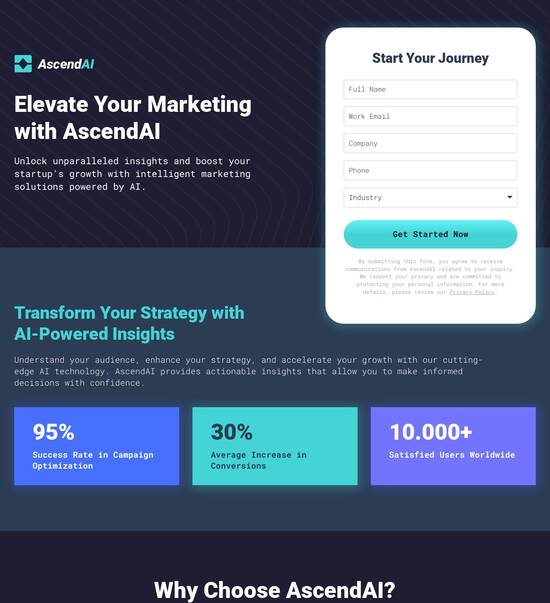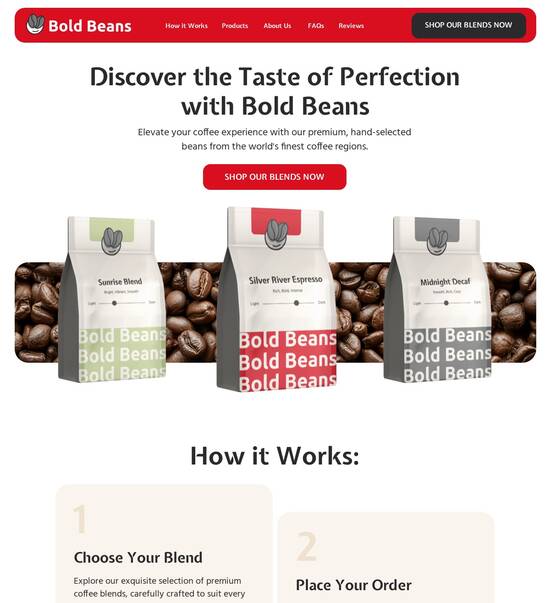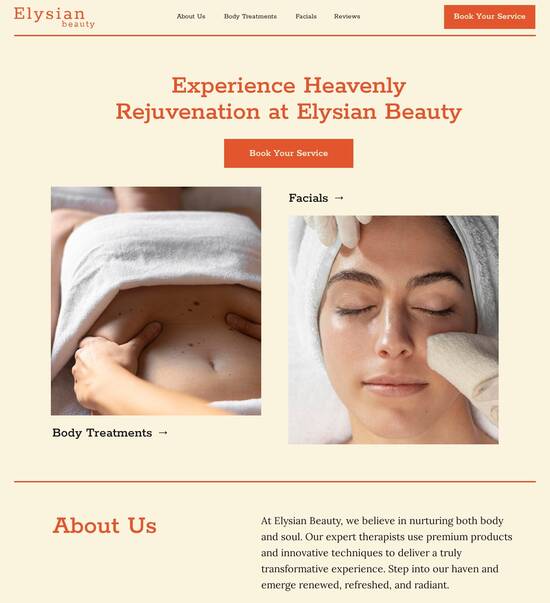
Next.js optimized chatbot page template
Explore Similar TemplatesAbout template
Supercharge your chatbot page with Next.js for outstanding performance! Learn more today.
Recommended templates

Easy to build without coding
With the intuitive drag-and-drop builder, anyone on your team can create high-converting pages without any knowledge of code or design. Make enhancements to your landing page with custom widgets using Javascript, HTML/CSS, or third-party scripts.

Multiple layouts for any industry and goal
Select from 500+ landing page layouts built to boost conversions across industry-specific scenarios. Customize them by adjusting fonts, adding images, and generating on-brand content with the AI assistant. Quickly scale with Instablocks® and Global Blocks that you can save, reuse, and update globally.

Loads fast and looks polished on any device
Every template is responsive, which means they present professionally on any device and load blazingly fast with our Thor Render Engine. You can also power them up with Google AMP technology to deliver an unparalleled mobile experience and drive higher conversions.

Robust analytics & experimentation
Get real-time updates and reporting across all your devices, showing the number of visitors, conversions, cost-per-visitor, and cost-per-lead. Launch AI-powered experiments, run A/B tests, and use heatmaps to analyze user behavior, then optimize your landing page to maximize conversions.







Easy to build without coding
With the intuitive drag-and-drop builder, anyone on your team can create high-converting pages without any knowledge of code or design. Make enhancements to your landing page with custom widgets using Javascript, HTML/CSS, or third-party scripts.
Multiple layouts for any industry and goal
Select from 500+ landing page layouts built to boost conversions across industry-specific scenarios. Customize them by adjusting fonts, adding images, and generating on-brand content with the AI assistant. Quickly scale with Instablocks® and Global Blocks that you can save, reuse, and update globally.
Loads fast and looks polished on any device
Every template is responsive, which means they present professionally on any device and load blazingly fast with our Thor Render Engine.
Robust analytics & experimentation
Get real-time updates and reporting across all your devices, showing the number of visitors, conversions, cost-per-visitor, and cost-per-lead. Launch AI-powered experiments, run A/B tests, and use heatmaps to analyze user behavior, then optimize your landing page to maximize conversions.
All the features you need to build next js chatbot template
Explore more featuresLearn how to build nextjs ai chatbot template
Frequently asked questions about embedable chatbot template nextjs python
Leading the way in building high-performing landing pages





React chatbotify: Your ultimate how-to guide
Understanding how to leverage Instapage effectively can significantly enhance your digital marketing campaigns. This guide will provide you with actionable insights on using Instapage's features to not only create stunning landing pages but also optimize them for conversion rates, ultimately maximizing your ROI. Whether you're in business services, tech, or financial services, this step-by-step approach ensures that you can adapt your strategies across sectors.
Setup your Instapage account for optimal results
The first step involves creating your Instapage account. Once you're set up, you'll have access to a library of over 100 high-converting templates tailored for various industries. This means you can choose a design that suits your audience from the get-go.
- Select a template that resonates with your brand and audience, ensuring visual alignment with your existing marketing materials.
- Customize the template using the intuitive drag-and-drop interface; this allows for seamless integration of your branding elements.
- Integrate lead generation elements such as forms and call-to-action buttons to capture potential customer information effectively.
Optimize your landing page for high conversions
Optimizing your landing page involves understanding user behavior and making data-driven adjustments. Utilization of A/B testing and heatmaps can help you gauge how users interact with your content.
- Conduct A/B tests to determine which headlines convert better, adjusting text based on performance analytics.
- Utilize heatmaps to visualize user engagement, revealing the most clicked areas and allowing refinements of CTAs.
- Regularly update your content to align with market trends and seasonal changes, ensuring timely relevance.
Personalize your user experience for greater engagement
Personalization is key to connecting with diverse audiences. Use Instapage's dynamic text replacement and audience segmentation functionalities.
- Employ dynamic text replacement to align landing pages with users' search queries, increasing engagement.
- Integrate audience-specific metrics and personalize content to resonate with different segments, enhancing relevance.
- Implement A/B testing not just on page layout but also on personalized messaging to continuously improve performance.
In conclusion, effectively using Instapage's capabilities allows marketers to design, optimize, and personalize their landing pages for maximum impact. This systematic approach paves the way for realizing better ROI through enhanced engagement strategies.
To start transforming your digital marketing campaigns today, visit Instapage and discover how you can harness the power of optimized landing pages to increase your leads and conversions.
People also ask about chatbot template nextjs
Unveiling the Next.js Optimized Chatbot Page Template
The emergence of chatbots in web development
Chatbots have increasingly become pivotal in web development, serving as reliable digital assistants that enhance user interaction. At their core, chatbots utilize artificial intelligence to simulate conversation with users, offering responses and support based on user input. They are designed to handle common queries and tasks, allowing businesses to maintain customer engagement without the need for extensive human resources.
In the realm of user experience, conversational AI is a game changer. By providing immediate responses and tailored interactions, chatbots can significantly enhance the overall experience of website visitors. Users are often more inclined to engage with a site that offers instant feedback, making chatbots a valuable addition to any digital strategy.
24/7 availability for customer inquiries.
Streamlined user experiences through quick responses.
Reduced operational costs by automating routine tasks.
The necessity for integrating chatbots into web design is underscored by their growing demand. Businesses and developers recognize the potential of real-time, AI-driven communication to not only improve customer service but also to gather insights on user behavior, ultimately refining their offerings.
Introduction to Next.js and its revolutionary features
Next.js is a powerful open-source React framework that has gained significant traction in the web development community. It provides both server-side rendering (SSR) and static site generation (SSG), making it an ideal choice for building highly interactive applications, including chatbots. With Next.js, developers can craft seamless user experiences that are not only fast but also optimized for search engines.
One of the standout features of Next.js is its capability to enable React server components. This allows developers to write components that load data on the server, improving performance and user experience. Furthermore, Next.js automatically splits code, ensuring that only necessary scripts are loaded, which is particularly beneficial for chatbot applications where performance is crucial.
Server-side rendering for improved SEO.
Automatic code splitting for faster load times.
Simplified API routes for backend operations.
Design and structure of the optimized chatbot page template
The design of an optimized chatbot page template in Next.js can significantly impact functionality and user engagement. The template typically consists of several core layout components, including a header, chat interface, and footer. This structure provides clarity and organization, allowing users to focus on their interactions without distractions.
Responsive design principles are essential in this context. Increasingly, users access websites via mobile devices, making it crucial that chatbot interfaces adapt to different screen sizes seamlessly. A well-designed chatbot page utilizes CSS Flexbox or Grid layouts to ensure that all elements adjust fluidly, providing a consistent experience across devices.
Header: Consists of branding and navigation elements.
Chat interface: The central and most interactive component.
Footer: Provides additional information and links.
In terms of code architecture, the core files and folders in the template should be logically organized. Utilizing JavaScript and React to manage dynamic content is paramount, as it allows developers to create interactive experiences that respond to user inputs in real-time.
Features of the Next.js chatbot template
One of the key features of a Next.js optimized chatbot template is its ability to easily integrate with various API services. Developers can connect their chatbot to AI SDKs and language models, facilitating advanced conversational abilities. Popular API providers such as OpenAI, Dialogflow, and Microsoft Azure are excellent candidates for this integration, each offering unique capabilities to enhance chatbot performance.
Server-side rendering (SSR) is another significant benefit when using Next.js for chatbots. By rendering content on the server before sending it to the client, SSR enhances loading times and improves SEO performance. This is especially important for chatbots, where user engagement can drop dramatically with slower load times.
API integration for sophisticated AI functionality.
SSR enhances SEO and boosts user engagement.
State management strategies using hooks and context API.
Effective state management is crucial for chatbots, facilitating real-time data handling across interactions. Techniques using React hooks and the context API enable developers to manage user inputs and chatbot responses efficiently. This makes it easier to create a dynamic dialogue that feels natural and intuitive.
Benefits of optimizing chatbot pages with Next.js
Choosing Next.js for chatbot development can lead to enhanced user experiences. The framework's focus on performance means faster load times, which are essential for keeping users engaged. Users appreciate a responsive interface where they can interact with a chatbot without lag, leading to improved satisfaction and retention rates.
Moreover, Next.js excels in performance optimization. By minimizing API call times and efficiently managing data flow, developers can ensure that chatbots operate without hiccups. This is vital in maintaining a seamless conversation experience, allowing users to communicate effectively.
Faster load times enhance overall user satisfaction.
Optimization reduces API call times and improves data management.
SSR improves visibility and search ranking.
From an SEO standpoint, adopting SSR in chatbot pages presents distinct advantages. Search engines favor pages that load quickly and provide rich content, both of which can be achieved through a well-structured Next.js chatbot implementation.
Practical implementation: Building your first chatbot page using Next.js
To begin developing a chatbot page with Next.js, setting up your development environment is crucial. Ensure you have Node.js installed and utilize a modern code editor like Visual Studio Code for optimal results. It's important to choose the right Next.js version that aligns with your project requirements as the framework continues to evolve.
The development process can be broken down into clear steps. Start by creating and configuring the chatbot component within your Next.js application. This involves defining how the chatbot will communicate with users and integrating necessary AI services through APIs.
Create your Next.js project using 'npx create-next-app'.
Develop the chatbot component using React and integration of AI APIs.
Deploy your chatbot page following best practices for optimal performance.
Deployment is another critical phase. Choose an efficient hosting provider that supports Next.js, ensuring your chatbot can scale seamlessly to meet user demands. Platforms like Vercel or Netlify are excellent choices for hosting.
Future trends in chatbot development and web technologies
The landscape of AI-powered chatbots is rapidly transforming, with advancements in language models driving user interactions. As chatbots become increasingly sophisticated, they are expected to utilize more natural language processing capabilities and engage with users more intuitively. This evolution presents exciting opportunities for developers to create more effective conversational agents.
Furthermore, the role of Next.js within the web development ecosystem continues to grow. As new JavaScript frameworks emerge, developers must stay informed about their potential impacts on chatbot design. Active communities surrounding these technologies also contribute to the wealth of resources available for developers looking to innovate in this space.
Emerging AI technologies enhancing chatbot functionalities.
Innovations in JavaScript frameworks impacting development practices.
The importance of community support for ongoing learning.
Real-world applications and case studies
Various businesses have successfully leveraged Next.js to develop and deploy efficient chatbot applications. By analyzing these real-world implementations, developers can extract valuable insights into best practices and performance metrics. For instance, companies in tech, education, and financial services have reported increased customer engagement and satisfaction since integrating chatbots, which offer immediate support and personalized interactions.
Learning from industry leaders can also provide essential guidance. By observing how established companies navigate challenges, developers can avoid common pitfalls and adapt successful strategies to their projects. Innovations derived from these case studies serve as inspiration for creating more robust and user-friendly chatbot solutions.
Analysis of chatbot deployment metrics for improved strategies.
Insights from successful integration of chatbots across sectors.
Best practices to follow and avoid common difficulties.
Challenges and considerations in chatbot development
Developing a chatbot is not without its challenges. Technical hurdles often arise during the integration process with various APIs. Ensuring that the chatbot can communicate effectively with underlying services while maintaining performance is vital. Additionally, developers must be aware of potential lag in conversational AI responses, which can negatively impact user experience.
User interaction design is equally important in chatbot development. An intuitive interface informs users how to engage with the chatbot effectively, while also ensuring the conversation feels coherent. Developers must balance automation capabilities with a personal touch to facilitate effective communication and maintain user engagement.
Addressing API integration challenges.
Managing the pace and flow of AI responses.
Prioritizing user-friendly interface design.
Crafting scalable solutions with Next.js
Scalability is a crucial consideration for chatbot applications, especially as user bases grow. Planning for server-side capacity and ensuring that the architecture supports load balancing are essential strategies for maintaining high performance under increased demand. This can include leveraging cloud solutions that allow for easy scaling based on user traffic.
Future-proofing chatbot pages involves staying informed about ongoing advancements in AI and web technologies. Developers should continually update their systems to accommodate new features and improvements that enhance user experience. Regularly revisiting and refining code ensures the chatbot remains relevant and effective over time.
implementing strategies for effective load balancing.
Maintaining adaptability as technologies evolve.
Regular code reviews and updates for optimal performance.
Ready to skyrocket conversions?
Supercharge your ad campaigns with high-performing landing pages
Get started














